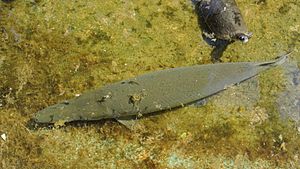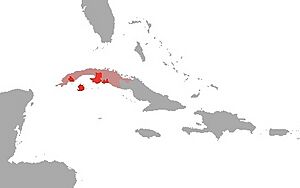Cuban gar facts for kids
Quick facts for kids Cuban gar |
|
|---|---|
 |
|
 |
|
| Conservation status | |
| Scientific classification | |
 |
|
| Synonyms | |
|
The Cuban gar (Atractosteus tristoechus), also called the manjuarí, is a type of fish that belongs to the Lepisosteidae family. This fish lives in tropical freshwater, but it can also be found in brackish water (a mix of fresh and salt water). You can find it in rivers and lakes in western Cuba and the Isla de la Juventud. While the meat of the Cuban gar can be eaten, its eggs are poisonous and should never be consumed by humans.
Cuban gars lay their eggs during certain seasons in the flooded areas of large rivers.
Contents
How Cuban Gars Behave
Cuban gars usually hunt by themselves. They tend to stay away from other gars. The only time they gather in groups is during their spawning season. At this time, about 20 gars might form a large hunting party. Sometimes, these big groups split into smaller ones. Then, two to eight male gars might follow a female.
What Cuban Gars Look Like
Adult Cuban gars are typically about 1 m (3.3 ft) long. However, they can grow as large as 2 m (6.6 ft). Their length does not change based on whether they are male or female. This makes the Cuban gar the second largest type of gar alive today, right after the alligator gar.
Cuban gars, like other gar species, are special because they can handle high levels of ammonia and nitrate in water. They can also breathe some air from outside the water if there isn't enough oxygen in the water. Plus, they are very good at resisting diseases.
How Baby Gars Grow
After hatching, baby Cuban gars go through three main stages as they grow. These stages are called attached (days 1–3), transitional (days 4–10), and free-swimming (days 11–18).
In the attached stage, the tiny gars start to develop their stomachs and intestines. This helps them switch from feeding on their egg yolk to eating regular food. Regular feeding begins during the transitional stage. In this stage, their organs grow more, and they no longer rely on the yolk. Their teeth also start to grow.
Once their stomach and intestines are fully separate and they are eating on their own, they are called "free-swimming." When they are babies, Cuban gars grow from about 1.5 cm (0.6 in) long in the attached stage to about 4 cm (1.6 in) long in the free-swimming stage.
Where Cuban Gars Live and What They Eat
Like other gar species, Cuban gars are top predators in freshwater places. Adult gars eat other freshwater fish and even birds. Young gars can be eaten by the largemouth bass (Micropterus salmoides), which was brought into their habitat.
Because they are at the top of the food chain, the number of Cuban gars has gone down a lot. This is due to too much fishing and losing their natural homes. Scientists are looking into ways to use gars to help bring back natural fish populations. This is called aquaculture, which means raising fish in controlled environments. However, these ideas have not been put into action yet.
Cuban gars are also being studied for something called broodstocking. This means raising them to help protect their species, which is threatened. It also helps reduce the pressure on wild fish populations. But so far, Cuban gar broodstocking for protecting the environment has not started.
See also
 In Spanish: Manjuarí para niños
In Spanish: Manjuarí para niños


